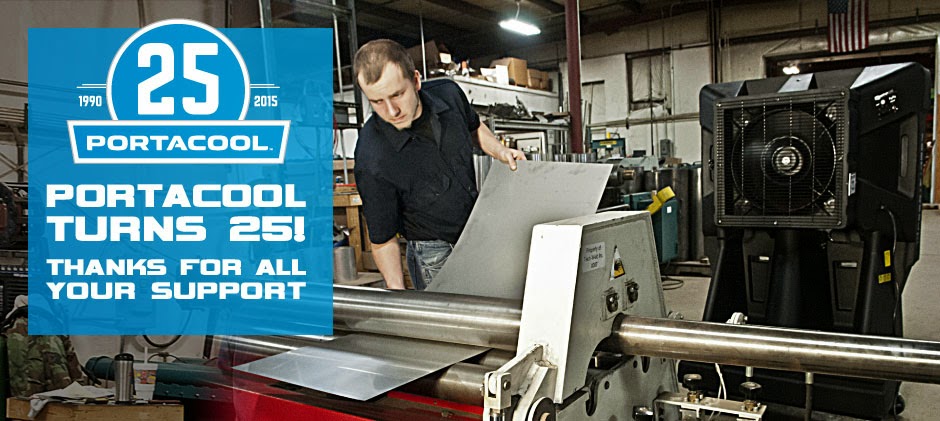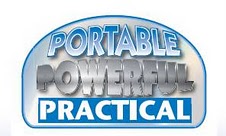Many
industries face challenges when it comes to providing a cool working
environment, particularly in heat-susceptible areas such as industrial
plants, warehouses, manufacturing facilities and outdoor jobsites. These
extreme-heat situations can impact worker safety and productivity, and
certainly, the company’s bottom-line.
Without adequate cooling,
workers are put in danger while equipment and manufactured products are
at an increased risk for failure.
According
to the Occupational Safety and Health Association (OSHA), thousands of
workers become sick from occupational heat exposure each year. However,
heat-related illnesses are preventable. “The best way to prevent
heat-related illness is to make the work environment cooler,” OSHA
states. The dilemma becomes how to effectively and economically cool
large, open areas where high-ambient outdoor temperatures and
heat-generating machinery are factors.
Weighing the drawbacks of typical cooling methods
Traditionally,
air conditioning (A/C) is a go-to cooling method. However, in large
open spaces, the first impediment is the inability to close the space
off and contain the inside air to achieve maximum cooling. Areas where
outside doors will be open, such as in a warehouse, allow air to escape
and render A/C an impractical solution.
Another
drawback is that air conditioners require compressors and a place to
ventilate the heat generated from the compressor. This limits the
mobility of an A/C unit given the fixed-ductwork and adds another point
of heat generation. Harsh refrigerants and energy consumption are other
downfalls. Refrigerants are an integral part of air conditioning systems
to emit cool air, and A/C can pull a great deal of energy that
translates to more energy expense.
Fans
– both oscillating and ceiling options – seem like a quick, inexpensive
fix to cooling workers and machinery. However, fans simply circulate
stagnate air throughout the space. The air is not chilled in any
capacity and cannot reach all areas of the large space to be cooled. In
fact, industrial ceiling fans seem to be particularly more effective in
the winter to improve heating operations by giving airflow to warm air.

An energy-efficient and cost-effective approach
OSHA
provides clear guidelines for heat-related illness prevention, listing
cooling fans as one of the top “engineering controls” for reducing
workers’ exposure to heat. Evaporative cooling products are essentially
cooling fans that use the naturally occurring process of evaporation to
cool warm air and drop temperatures. Evaporative cooling is, quite
simply, cooling with water. By evaporating water, the temperature of the
air in contact with the liquid water will lower as an endothermic
reaction takes place. During this reaction, the liquid water changes to a
gas and the temperature of the air lowers. In short, by pulling air
across water, the temperature of the air will lower. A control system
within the evaporative cooler operates the pump to assist in creating
this effect and the fan distributes the cool air.

A
good example of evaporative cooling at work is the cooling sensation
felt when climbing out of a swimming pool, when your body sweats or even
when a breeze blows across a lake. That cooling sensation you feel when
getting out of the pool is actually the theoretical limit and is known
as the wet-bulb temperature. For your given ambient conditions you can
find this theoretical limit from a psychrometric chart.
An
evaporative cooler actually works best with a supply of outside ambient
air to deliver a temperature reduction by as much as 7 degrees Celsius.
While evaporative coolers achieve significant temperature drops in more
arid climates and drier spaces, they provide relief from the heat in any
climate. For example, in regions where relative humidity reaches 70% at
midday with temperatures over 30 degrees Celsius, evaporative coolers
have been shown to offer noteworthy relief. Given that relative humidity
is lowest in the afternoon when the temperature
is at its highest, an effective evaporative cooling scenario is achievable.
Example:
Evaporative coolers have been proven to deliver a temperature reduction
from 3 to 6 degrees in the morning in the highest humidity regions
(Barcelona, The Netherlands), and up to 4 to 8 degrees later in the day
when the relative humidity goes down as the temperature goes up.
The
technology at the center of an evaporative cooling system is the
cellulose pad that collects water. Air passes through the pads and is
cooled as the water evaporates. The cellulose pad material is specially
treated to prevent deterioration as well as ensure a long service life. A
special water distribution system spreads water over the surface of the
pad within the cooling unit to ensure a uniform water supply. This
keeps the entire air-contact surface of the pad thoroughly wet. A
control system operates the water pump and distributes the cool air.
Today’s evaporative coolers are not yester year’s swamp coolers
While
evaporative coolers use the same general principles as antiquated swamp
coolers, the technology of modern-day evaporative coolers has evolved
to become much more energy efficient and effective. It can be said that
an evaporative cooler’s operation hinges squarely on the pad technology.
A quality pad, manufactured in a trustworthy facility by expertly
trained technicians, is an important element to selecting a long-lasting
evaporative cooler. The best pads have been treated during their curing
process to maximize the interaction between air and water for superior
cooling. Additionally, with improved design efficiency, today’s
evaporative coolers are among the most energy-efficient cooling methods
available. Many require the same amount of electricity used to run
standard household appliances and operate for cents an hour.

Selecting the right evaporative cooler for the space
Size.
Evaporative coolers are available in a variety of sizes, making it
simple to customize cooling for both indoor and outdoor spaces. Units
are typically available to accommodate areas ranging from 45 to 371
square meter.
To cool even larger areas, two or more evaporative
coolers can be used together to create a comfortable environment.
Portability and easy control functions. Portability is an enormous
benefit of evaporative coolers. With heavy-duty casters, evaporative
cooling units can be easily moved from smooth to rough terrain by one
person. Water hose connections also enhance mobility, as there is no
need to stay near a faucet in order to refill the water reservoir.
Manufacturer.
When researching and selecting the best evaporative cooler for your
needs, a great place to begin is with the manufacturer. Choose a company
that manufacturers their own parts in reputable facilities. Be certain
to understand the kinds of pads and cooling technology that is utilized
in the evaporative cooler you select. This extra research upfront will
provide peace-of-mind in ensuring product longevity.
It
is true that most heat-related health problems can be prevented, or at
least the risk of developing them can be reduced. Take a proactive
approach and begin carefully weighing cooling options. By benefiting the
comfort of employees, you are effectively benefiting the company’s
bottom dollar.
About the author
 Scott Jacobs, PE
Scott Jacobs, PE
Director of Engineering at Port-A-Cool, LLC
Scott
is a Registered Professional Engineer in Mechanical Engineering with
degrees from Kansas State University (BSME), University of Illinois
Urbana-Champaign (MSME), and Bradley University (MSEE).
He has extensive experience in industrial design and
commercial product design, including nine years at GE, nine years at Electrolux, and 13 years at Robert Bosch














